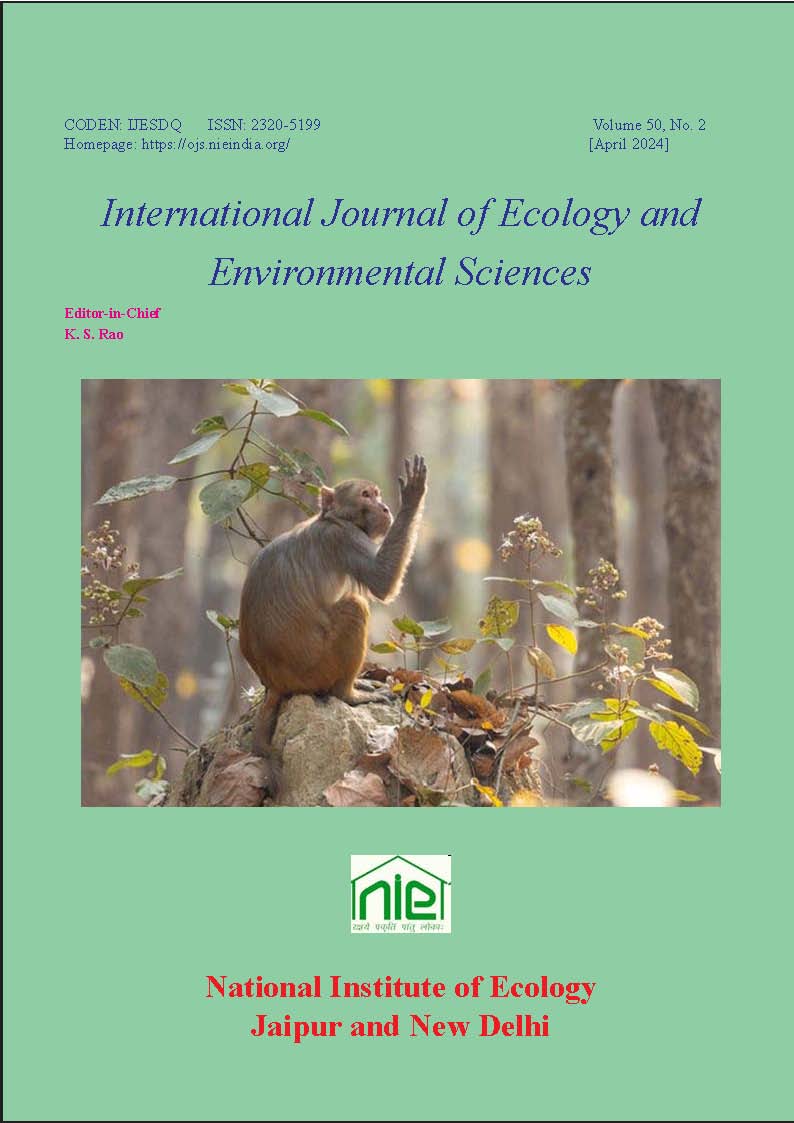Performance Evaluation of Two Stage Wastewater Model for Treatment of Dairy Effluents
DOI:
https://doi.org/10.55863/ijees.2024.3122Keywords:
Dairy wastewater, Physicochemical analysis, Bioremediation, Microbial characterization, Effluent treatment, Sustainable wastewater treatmentAbstract
The continuous rise in consumer demand for dairy products has led to significant advancements in food and dairy technology, resulting in a substantial increase in dairy production. However, the expansion of the dairy industry has placed a strain on the environment due to the generation of waste products containing elevated levels of constituents such as casein, lactose, fat, inorganic salts, as well as detergents and sanitizers. These contribute to elevated Chemical Oxygen Demand (COD) and Biological Oxygen Demand (BOD) values. While dairy facilities have implemented their own treatment plants to address these environmental challenges, there is an ongoing need to assess the efficiency of these wastewater treatment systems.
In this study, a two-stage model was developed, comprising a primary tank involving microbial treatment and a secondary tank with a layer of activated charcoal powder at the bottom and sawdust above it. The treated dairy effluent from these filtration units underwent analysis for various physicochemical parameters and was compared with samples obtained directly from the dairy industry. A total of eight indigenous bacterial isolates were derived from the processing of dairy wastewater through the model. Isolates R2 and R3 were obtained from raw wastewater, S1, S2, S3 isolates from secondary treated effluent, and T1, T2, T3 isolates from tertiary treated effluent. These isolates were further characterized biochemically as Micrococcus spp., Staphylococcus aureus, Bacillus spp., Staphylococcus spp., etc. Among all isolates, S3 demonstrated the highest reduction efficiency in water parameters, namely Electrical Conductivity, Chemical Oxygen Demand, and Biochemical Oxygen Demand, with reductions of 59.26%, 70.19%, and 74%, respectively
References
Ahmed, J., Thakur, A.and Goyal, A.2021. Industrial wastewater and its toxic effects. pp1-11. In: Shah, M.P. (Ed), Biological Treatment of Industrial Wastewater. The Royal Society of Chemistry. https://doi.org/10.1039/9781839165399-00001
Ahmad, T., Aadil, R.M., Ahmed, H., Soares, B.C.V., Souza, S.L.Q., Pimentel, T.C., Scudino, H., Guimar˜aes, J.T., Esmerino, E.A., Freitas, M.Q., Almada, R.B., Vendramel, S.M.R., Silva, M.C., Cruz, A.G. and Rahman, U. 2019. Treatment and utilization of dairy industrial waste: A review. Trends Food Science Technology, 88, 361–372. https://doi.org/10.1016/j.tifs.2019.04.003
Al-Wasify, R.S., Ali, M.N. and Hamed, S.R. 2017. Biodegradation of dairy wastewater using bacterial and fungal local isolates. Water Science and Technology, 76(11), 3094-3100. https://doi.org/10.2166/wst.2017.481
Anonymous. 2005. Standard Methods for the Examination of Water and Wastewater. American Public Health Association (APHA), Washington, DC, USA.
Bhambri, A., Karn, S.K. and Singh, R.K. 2021. In-situ remediation of nitrogen and phosphorus of beverage industry by potential strains Bacillus sp. (BK1) and Aspergillus sp. (BK2). Scientific Reports, 11(1), 12243. https://doi.org/10.1038/s41598-021-91539-y
Biswas, T., Chatterjee, D., Barman, S., Chakraborty, A., Halder, N., Banerjee, S. and Chaudhuri, S.R. 2019. Cultivable bacterial community analysis of dairy activated sludge for value addition to dairy wastewater. Microbiology and Biotechnology Letters, 47(4), 585-595. https://doi.org/10.4014/mbl.1901.01014
Das, A., Kundu, P. and Adhikari, S. 2022. Two stage treatability and biokinetic study of dairy wastewater using bacterial consortium and microalgae. Biocatalysis and Agricultural Biotechnology, 43, 102387. https://doi.org/10.1016/j.bcab.2022.102387
Guillen-Jimenez, E., Alvarez-Mateos, P., Romero-Guzman, F. and Pereda-Marin, J. 2000. Bio-mineralization of organic matter in dairy wastewater, as affected by pH. The evolution of ammonium and phosphates. Water Research, 34(4), 1215-1224. https://doi.org/10.1016/S0043-1354(99) 00242-0
Healy, M.G., Bustos, R.O., Solomon, S.E., Devine, C. and Healy, A. 2010. Biotreatment of marine crustacean and chicken egg shell waste. pp. 320–319. In: Moo-Young, M., Anderson, W.A. and Chakrabarty, A.M. (Eds.), Environmental Biotechnology (1stedition.). Springer, Dordrecht. https://doi.org/10.1007/978-94-017-1435-8
Krishna, K.R. and Philip, L. 2005. Bioremediation of Cr (VI) in contaminated soils. Journal of Hazardous Materials, 121(1-3), 109-117. https://doi.org/10.1016/j.jhazmat.2005. 01.018
Kumar, D. and Desai, K. 2011. Pollution abatement in milk dairy industry. Journal of Current Pharma Research, 1(2), 145. https://doi.org/10.33786/JCPR.2011.V01I02.010
Kushwaha, J.P., Srivastava, V.C. and Mall, I.D. 2011. An overview of various technologies for the treatment of dairy wastewaters. Critical Reviews in Food Science and Nutrition, 51(5), 442-452. https://doi.org/10.1080/1040839100 3663879
Mansoorian, H.J., Mahvi, A.H., Jafari, A.J. and Khanjani, N. 2016. Evaluation of dairy industry wastewater treatment and simultaneous bioelectricity generation in a catalyst-less and mediator-less membrane microbial fuel cell. Journal of Saudi Chemical Society, 20(1), 88-100. https://doi.org/10.1016/j.jscs.2014.08.002
Munavalli, G.R. and Saler, P.S. 2009. Treatment of dairy wastewater by water hyacinth. Water Science and Technology, 59(4), 713-722. https://doi.org/10.2166/wst.2009.008
Porwal, H.J., Mane, A.V. and Velhal, S.G. 2015. Biodegradation of dairy effluent by using microbial isolates obtained from activated sludge. Water Resources and Industry, 9, 1-15. https://doi.org/10.1016/j.wri.2014.11.002
Stanchev, P., Vasilaki, V., Egas, D., Colon, J., Ponsá, S. and Katsou, E. 2020. Multilevel environmental assessment of the anaerobic treatment of dairy processing effluents in the context of circular economy. Journal of Cleaner Production, 261, 121-139. https://doi.org/10.1016/j.jclepro. 2020.121139
Thakur, S., Kavia, A., Saxena, S., Arora, S. and Mathur, A.K. 2016. Bioremediation of diesel by isolated bacterial species from River Chambal in Kota Region. International Journal Current Microbiology Applied Science, 5(12), 465-474. http://dx.doi.org/10.20546/ijcmas.2016.512.050
Yathavamoorthi, R., Surendraraj, A. and Farvin, K.H.S. 2010. Enteric bacteria and water quality of freshwater prawn Macrobrachium rosenbergii (De Man) in a culture environment from Kerala, India. Journal of Fisheries and Aquatic Science, 5(3), 282-292. https://doi.org/10.3923/jfas.2010.282.292
Downloads
Published
How to Cite
Issue
Section
License
Copyright (c) 2023 Sonika Saxena, Tejaswini Kumawat, Ramakant Lata, Jayana Rajvanshi, Sudipti Arora

This work is licensed under a Creative Commons Attribution-NonCommercial 4.0 International License.


